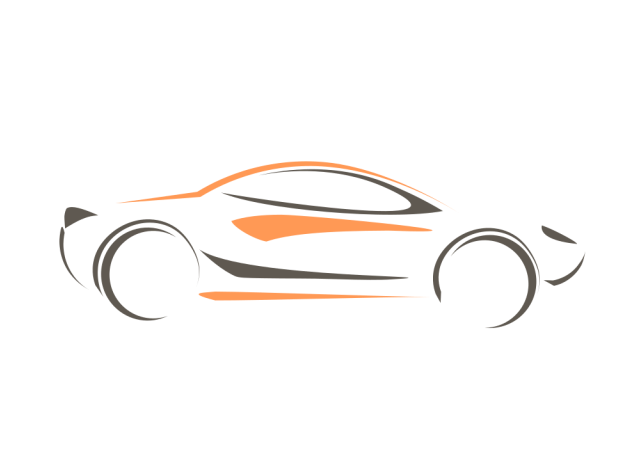Автомат
Версии с механической коробкой передач Kia Sorento Prime как-то не досталось. Только «автомат». Причём, традиционный, гидромеханический и, как следствие, надёжный. До рестайлинга 2017 это был 6-скоростной агрегат A6LF2. Бывали случаи преждевременного выхода из строя гидротрансформатора, но почти всегда КПП менялись по гарантии. Бывало, что масло недоливали ещё на заводе, из-за чего могут ощущаться подпинывания, которые опять же устранялись ещё при дилерском «уходе». Ресурс автомата до первого кап.ремонта весьма средний – 200 — 250 000 км.
После рестайлинга своё место в цепочке трансмиссии занял 8-ступенчатый «автомат» A8MF1, у которого при тех же габаритах прибавилась ещё пара пакетов фрикционов. Немного усложнили, но пока владельцы явных проблем не замечают, что не может не радовать.
Подвеска и заводские оказии
Меньше всего внимания владельцам приходится уделять подвеске. Она простая и неприхотливая. Правда о некоторых слабых местах лучше знать заранее. Самым главным просчётом можно считать неотрегулированные углы установки колес («развал»), с которыми Sorento порой выезжал прямо из автосалона. Некоторым владельцам приходилось проводить эту процедуру сразу после покупки авто.
Вторая проблема – задние амортизаторы. Слабенькие, не самые ресурсные: бывает, что не дотягивают до 50000 км:
Шаровые опоры первое время тоже не отличались надежностью, однако чаще всего их меняли по отзывной кампании на модернизированные, что сводит проблему на нет. В остальном сроки жизни элементов ходовой и рулевого управления вполне средние. Втулки и стойки стабилизатора живут около 100 000 км, сайлентблоки рычагов (передних и задних) около 150 ткм.
Передняя подвеска Kia Sorento 3 Prime
Многих владельцев Sorento 3 беспокоит шуршание в салоне при вывороте колес. Дилеры причину такого слухового беспокойства не называют, просто без разбора меняют всю рулевую колонку целиком, что не оставляет посторонним звукам никакого шанса.
Задняя подвеска Kia Sorento 3 Prime
Немного вопросов возникает и к тормозам. Передние диски не особо производительные, от чего могут быстро перегреться и начать бить в руль при замедлении. Как отчитываются сами владельцы, если правильно подобрать неоригинальные фрикционы, то таких проблем больше не будет:
Headlights
Ratings are given for 2 different headlight variations available on this vehicle.
Trim level(s)
-
SX trim equipped with SX Touring package
- SXL trim
| Low-beam headlight type | LED projector |
|---|---|
| High-beam headlight type | LED projector |
| Curve-adaptive? | Yes |
| High-beam assist? | Yes |
| Overall rating | G |
| Distance at which headlights provide at least 5 lux illumination: |
car-simplercar-simplercar-simplercar-simplercar-simpler0 ft100 ft200 ft300 ft400 ft500 ft600 ftLow beamsOptimal low-beamilluminationHigh beamsOptimal high-beamilluminationHigh-beam assist credit
Low beams On the straightaway, visibility was good on both sides of the road. On curves, visibility was good on the sharp left and both right curves and fair on the gradual left curve.
The low beams never exceeded glare limits.
High beams On the straightaway, visibility was good on the right side of the road and inadequate on the left side. On curves, visibility was good on the gradual right curve and fair on the sharp right and both left curves.
High-beam assist compensates for some limitations of this vehicle’s low beams on both left curves.
Technical measurements for this test
| Trim level(s) |
|
|---|---|
| Low-beam headlight type | LED projector |
| High-beam headlight type | LED projector |
| Curve-adaptive? | Yes |
| High-beam assist? | Yes |
| Overall ratingApplies to 2019-20 models | G |
| LOW BEAMS | Average minimum useful illumination distance (5 lux) | Amount glare exceeded threshold |
|---|---|---|
| Straightaway right edge | 132.4 m | None |
| Straightaway left edge | 83.5 m | None |
| 250m radius right curve, right edge | 80.9 m | None |
| 250m radius left curve, right edge | 63.8 m | None |
| 150m radius right curve, right edge | 64.9 m | None |
| 150m radius left curve, left edge | 58.8 m | None |
| HIGH BEAMS | Average minimum useful illumination distance (5 lux) |
|---|---|
| Straightaway right edge | 153.9 m |
| Straightaway left edge | 108.8 m |
| 250m radius right curve, right edge | 79.6 m |
| 250m radius left curve, left edge | 73.3 m |
| 150m radius right curve, right edge | 62.9 m |
| 150m radius left curve, left edge | 59.1 m |
Trim level(s)
- L trim
- LX trim
- LX V6 trim
- EX V6 trim
- SX trim
| Low-beam headlight type | Halogen projector |
|---|---|
| High-beam headlight type | Halogen projector |
| Curve-adaptive? | No |
| High-beam assist? | No |
| Overall rating | P |
| Distance at which headlights provide at least 5 lux illumination: |
car-simplercar-simplercar-simplercar-simplercar-simpler0 ft100 ft200 ft300 ft400 ft500 ft600 ftLow beamsOptimal low-beamilluminationHigh beamsOptimal high-beamilluminationSome glare
Low beams On the straightaway, visibility was fair on both sides of the road. On curves, visibility was inadequate in all 4 tests.
The low beams created some glare.
High beams On the straightaway, visibility was good on both sides of the road. On curves, visibility was inadequate in all 4 tests.
Technical measurements for this test
| Trim level(s) |
|
|---|---|
| Low-beam headlight type | Halogen projector |
| High-beam headlight type | Halogen projector |
| Curve-adaptive? | No |
| High-beam assist? | No |
| Overall ratingApplies to 2016-20 models | P |
| LOW BEAMS | Average minimum useful illumination distance (5 lux) | Amount glare exceeded threshold |
|---|---|---|
| Straightaway right edge | 83.7 m | 33.8 % |
| Straightaway left edge | 46.0 m | 33.8 % |
| 250m radius right curve, right edge | 51.7 m | None |
| 250m radius left curve, left edge | 41.9 m | None |
| 150m radius right curve, right edge | 43.8 m | 8.9 % |
| 150m radius left curve, left edge | 38.7 m | None |
| HIGH BEAMS | Average minimum useful illumination distance (5 lux) |
|---|---|
| Straightaway right edge | 162.1 m |
| Straightaway left edge | 156.0 m |
| 250m radius right curve, right edge | 62.8 m |
| 250m radius left curve, left edge | 58.5 m |
| 150m radius right curve, right edge | 49.8 m |
| 150m radius left curve, left edge | 48.0 m |
Side: original test
Rating applies to 2011-13 models built after March 2010
Tested vehicle: 2011 Kia Sorento EX 4-door 4wd with standard front and second row head curtain airbags and standard front seat-mounted torso airbags
The Kia Sorento was redesigned for the 2011 model year (there was no 2010 model). Beginning with 2011 models built after March 2010, design changes were made to the front door trim to improve occupant protection in side impact crashes (note: information about when a specific vehicle was manufactured is on the certification label typically affixed to the car on or near the driver door).
| Overall evaluation | G |
|---|---|
| Structure and safety cage | A |
| Driver injury measures | |
| Head/neck | G |
| Torso | G |
| Pelvis/leg | G |
| Driver head protection | G |
| Rear passenger injury measures | |
| Head/neck | G |
| Torso | G |
| Pelvis/leg | G |
| Rear passenger head protection | G |
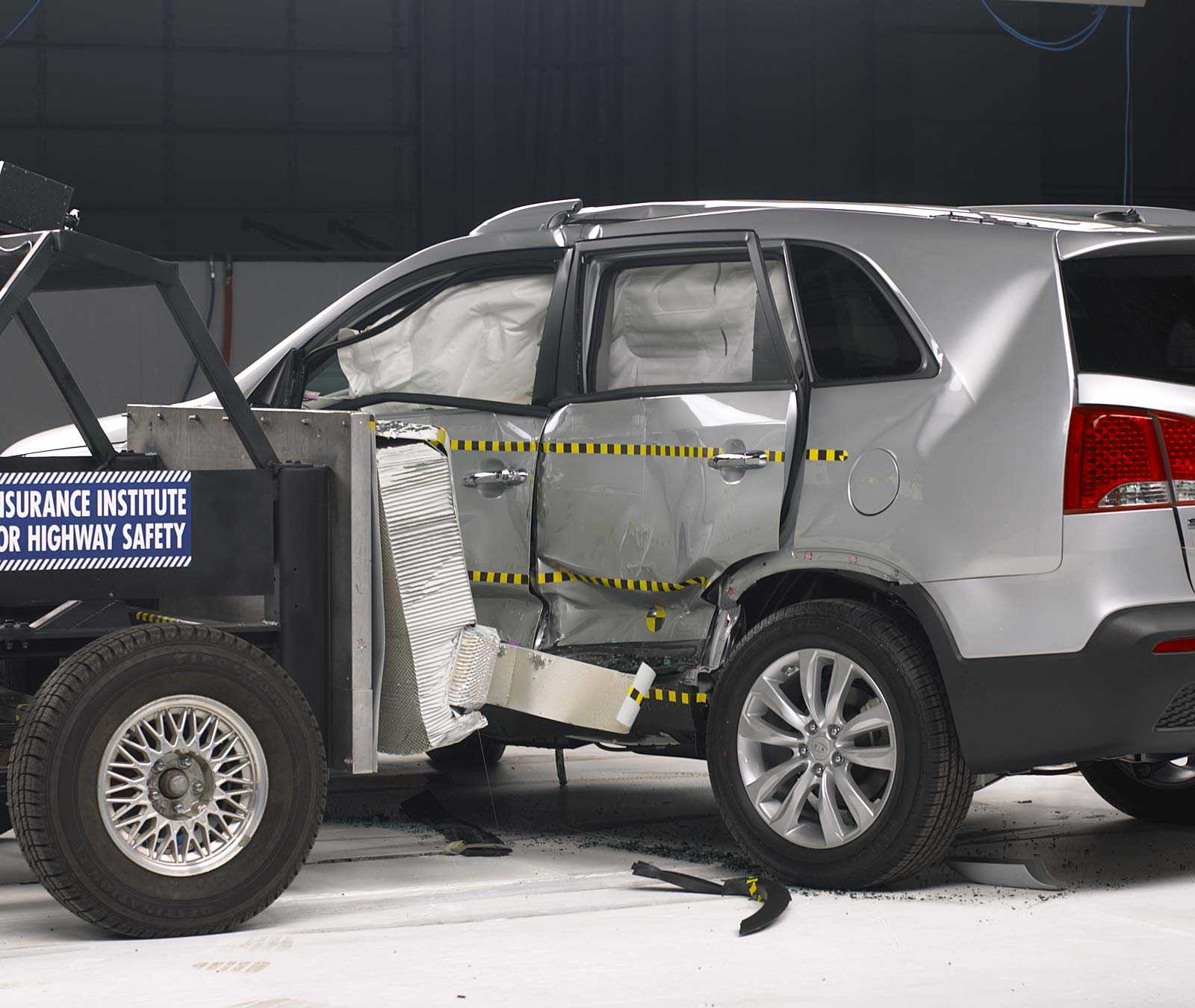
View of the vehicle and barrier just after the crash test.
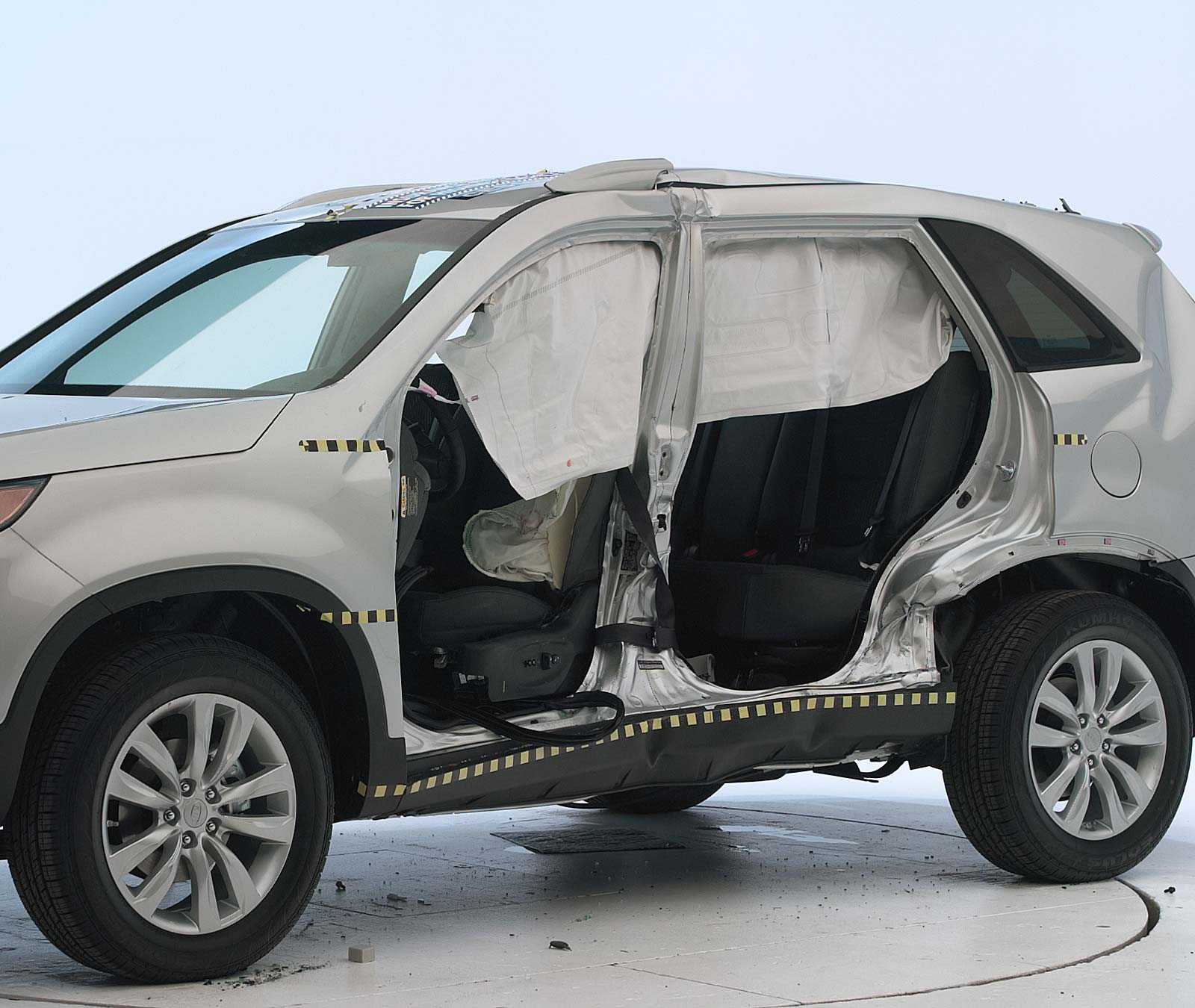
View of the vehicle after the crash with doors removed, showing the side airbags and damage to the occupant compartment.
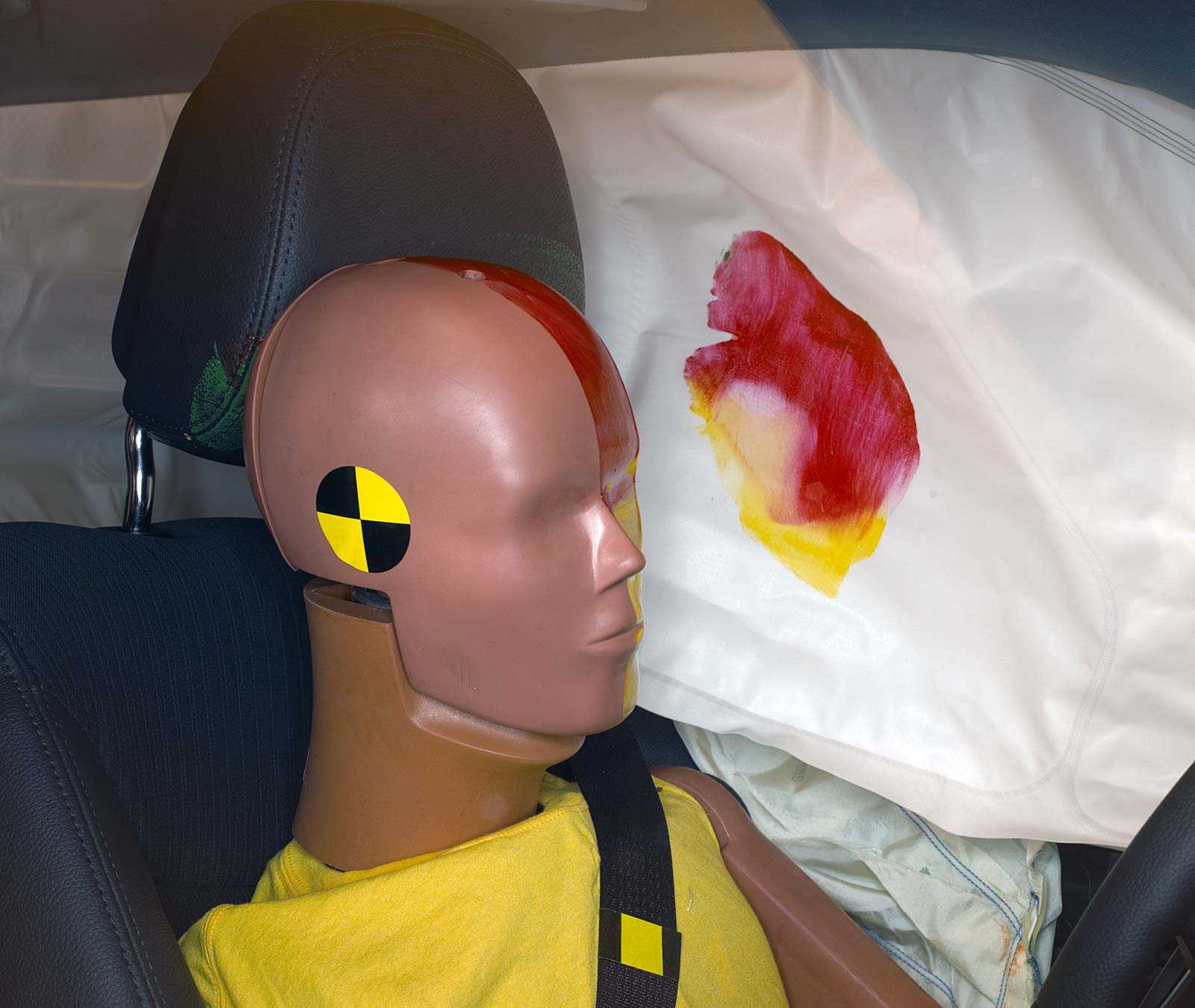
Smeared greasepaint shows where the driver dummy’s head was protected from being hit by hard structures by the side curtain airbag.
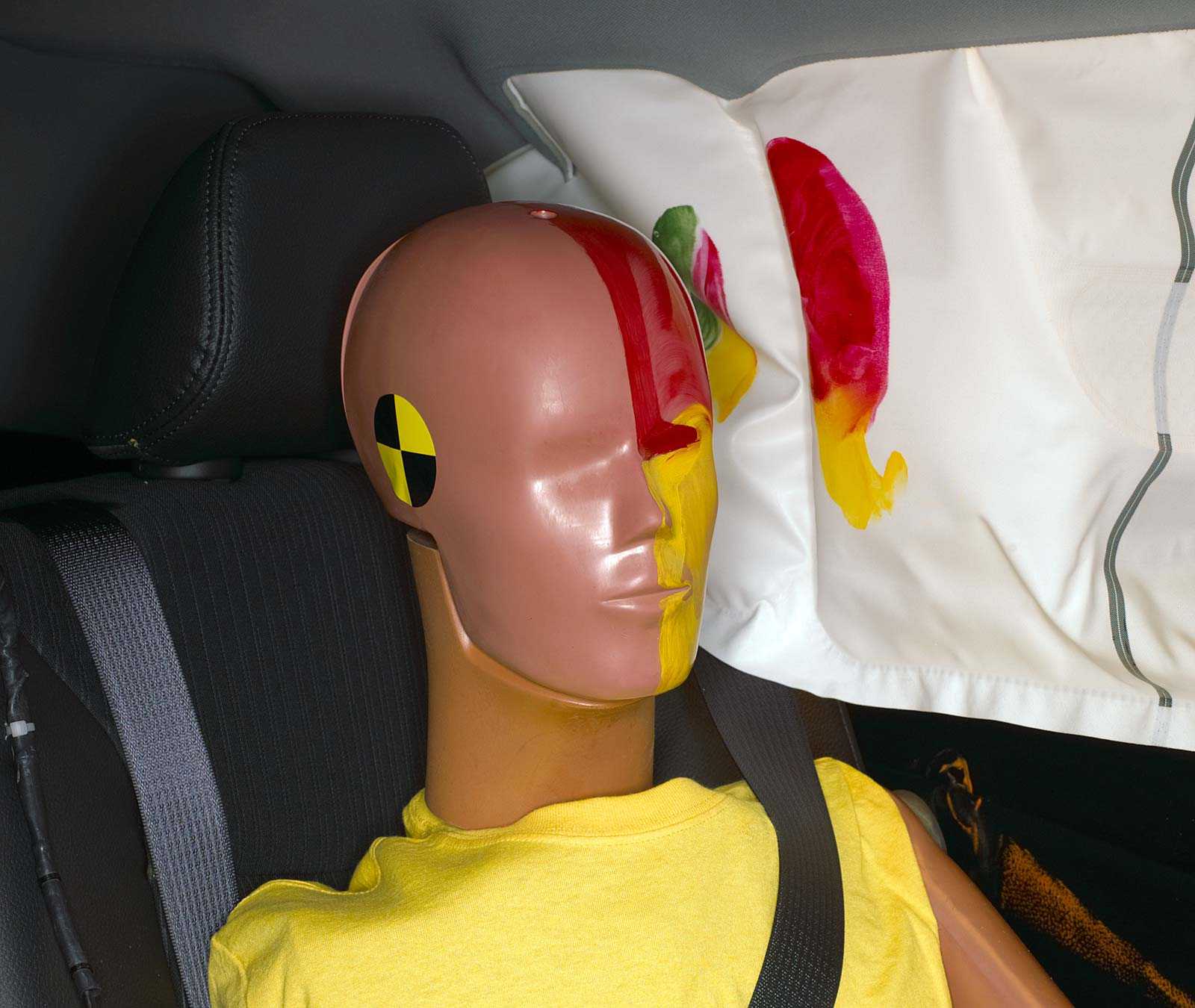
Smeared greasepaint shows where the rear passenger dummy’s head was protected by the side airbag.
Technical measurements for this test
Measures of occupant compartment intrusion on driver side
| Test ID | CES1006 |
|---|---|
| B-pillar to longitudinal centerline of driver’s seat (cm) | -8.5 |
| Negative numbers indicate the amount by which the crush stopped short of the seat centerline. |
Driver injury measures
| Test ID | CES1006 |
|---|---|
| Head HIC-15 | 186 |
| Neck | |
| Tension (kN) | 1.2 |
| Compression (kN) | 0.3 |
| Shoulder | |
| Lateral deflection (mm) | 23 |
| Lateral force (kN) | 1.6 |
| Torso | |
| Maximum deflection (mm) | 25 |
| Average deflection (mm) | 24 |
| Maximum deflection rate (m/s) | 3.54 |
| Maximum viscous criterion (m/s) | 0.38 |
| Pelvis | |
| Iliac force (kN) | 3.5 |
| Acetabulum force (kN) | 1.3 |
| Combined force (kN) | 4.2 |
| Left femur | |
| L-M force (kN) | 0.4 |
| L-M moment (Nm) | 59 |
| A-P moment (Nm) | 30 |
Passenger injury measures
| Test ID | CES1006 |
|---|---|
| Head HIC-15 | 120 |
| Neck | |
| Tension (kN) | 0.4 |
| Compression (kN) | 0.4 |
| Shoulder | |
| Lateral deflection (mm) | 30 |
| Lateral force (kN) | 1.3 |
| Torso | |
| Maximum deflection (mm) | 27 |
| Average deflection (mm) | 24 |
| Maximum deflection rate (m/s) | 4.26 |
| Maximum viscous criterion (m/s) | 0.55 |
| Pelvis | |
| Iliac force (kN) | 1.0 |
| Acetabulum force (kN) | 3.3 |
| Combined force (kN) | 4.1 |
| Left femur | |
| L-M force (kN) | 0.5 |
| L-M moment (Nm) | 63 |
| A-P moment (Nm) | 26 |
Small overlap front: driver-side
Rating applies to 2021-23 models
Tested vehicle: 2021 Kia Sorento S 4-door 4wd
The Kia Sorento was redesigned for the 2021 model year. Driver-side small overlap frontal ratings are assigned by the Institute based on a test of a 2021 Kia Sorento conducted by Hyundai/Kia as part of frontal crash test verification.
Measures of occupant compartment intrusion on driver side
| Test ID | VTN2013 |
|---|---|
| Lower occupant compartment | |
| Lower hinge pillar max (cm) | 11 |
| Footrest (cm) | 7 |
| Left toepan (cm) | 6 |
| Brake pedal (cm) | 2 |
| Parking brake (cm) | 9 |
| Rocker panel lateral average (cm) | 5 |
| Upper occupant compartment | |
| Steering column | 1 |
| Upper hinge pillar max (cm) | 4 |
| Upper dash (cm) | 6 |
| Lower instrument panel (cm) | 8 |
Driver injury measures
| Test ID | VTN2013 |
|---|---|
| Head | |
| HIC-15 | 83 |
| Peak gs at hard contact | no contact |
| Neck | |
| Tension (kN) | 0.9 |
| Extension bending moment (Nm) | 10 |
| Maximum Nij | 0.18 |
| Chest maximum compression (mm) | 24 |
| Femur (kN) | |
| Left | 1.0 |
| Right | 0.8 |
| Knee displacement (mm) | |
| Left | 3 |
| Right | 2 |
| Knee-thigh-hip injury risk (%) | |
| Left | |
| Right | |
| Maximum tibia index | |
| Left | 0.56 |
| Right | 0.53 |
| Tibia axial force (kN) | |
| Left | 2.2 |
| Right | 0.7 |
| Foot acceleration (g) | |
| Left | 35 |
| Right | 38 |
Kia Sorento
Более подробная информация в разделе «Общие комментарии» оценки
Более подробная информация на вкладке «Срок действия рейтингов» оценки
Водитель или взрослый пассажир
Уязвимые участники дорожного движения
Устройства обеспечения безопасности
- Хорошая
- Достаточная
- Низкая
- Слабая
- Плохая
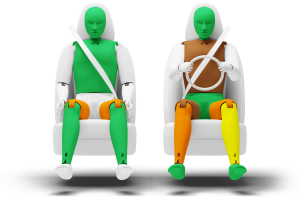
| Спасательная карточка | Available, ISO compliant |
| Расширенная система eCall | Available |
| Система торможения для предотвращения последующих столкновений | Available |
The passenger compartment remained stable in the offset frontal test. Protection of the driver’s chest was rated as weak, based on dummy measurements of compression. Dummy measurements showed weak protection of the driver’s right femur. Although other readings were good, protection was rated as marginal because of structures in the dashboard which could cause a risk to occupants of different sizes or those sitting in different positions. Analysis of the barrier into which the Sorento crashed showed some localised areas of high deformation and a modest penalty was applied to the score for the risk this represented to the opposing vehicle. In the full-width, rigid wall test, protection was good or adequate for all critical body regions for both the driver and the rear seat passenger. In the side barrier test, representing a collision by another vehicle, protection was good for all critical body areas. Similarly, in the more severe side pole impact, protection was at least adequate. In an assessment of protection in far-side impact, dummy excursion (its movement towards the other side of the vehicle) was rated as adequate. The Sorento is equipped with a centre airbag to protect against occupant-to-occupant interaction in side impacts. This system worked well in Euro NCAP’s test, with good protection of the head for both front seat occupants. Tests on the front seats and head restraints demonstrated good protection against whiplash injury in the event of a rear-end collision. A geometric assessment of the rear seats also indicated good whiplash protection. The Sorento is equipped as standard with a multi-collision braking system, which applies the brakes immediately after an impact to prevent the vehicle from being involved in secondary impacts. The car also has an advanced e-Call system which, in the event of an accident, automatically sends a message to the emergency services, giving the car’s location.
Источник
Кузов и внешний вид
Придираться к кузову Kia Sorento Prime сложно. Даже сквозь года и десятки тысяч километров внешний вид у кроссовера остаётся вполне свежим и одновременно крутым. Сколы, конечно же образуются, особенно у трассовых машин, да и коррозия в местах повреждений через пару месяцев начинает покрываться рыжей пленкой, но дальше этого дело не заходит, если не было серьезных деформаций металла, то есть ДТП.
Иногда на передней части крыши можно увидеть ржавые пятна, которые медленно из года в год ползут по всей кромке
Хром со временем покидает решетку радиатора и другие декоративные элементы. Это закономерно. Даже представители премиум-сегмента грешат тем же. Что уж хотите от Kia?
Панорамная крыша с люком добавляет повод для профилактики
Запотевание фар у Sorento Prime за неисправность принимать не стоит, хоть и выглядит это всё некрасиво. Дилеры порой меняют их по гарантии, правда гарантий того, что рецидива не случится, никаких.
Specifications
Powertrain
The new generation of Kia Sorento in Europe will initially receive three engine variants: two diesel engines and one gasoline one. The gasoline engine has a gas distribution system with 16 valves. Diesel engine allows the customer to choose the transmission: 6-speed manual transmission or 6-range automatic gearbox. The possible 3.3-liter engine will be able to reach the mark of 100 km/h in just 8.2 seconds, and its appetite will be about 10.5 liters of gasoline per 100 kilometers. Thanks to the modernization of the base, Sorento’s KIA was able to improve its own cross-country ability, control and comfort.
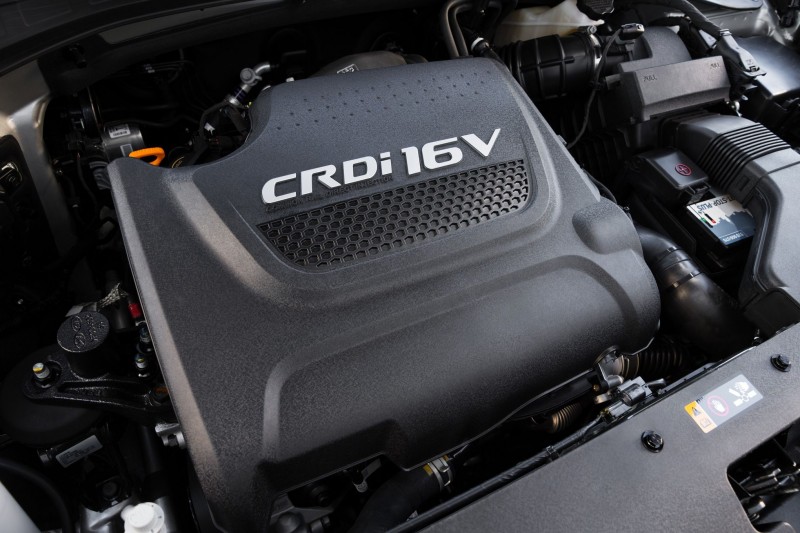
If we’re talking about the drive, it could be either full or front. Manufacturers assure that KIA Sorento 2016 has acquired auxiliary electronic help systems, such as blind spot and lane tracking, frontal collision avoidance, adaptive cruise control and a parking assistant using the reverse direction, which reports the presence of moving vehicles. Thanks to the unique security system TVCC, which makes it possible to automatically monitor the process of entering the turns of the car, which makes it much smoother, safer and more organic.
Dimensions
If we talk about the dimensions of KIA Sorento – they are as follows: it is 4,780 mm long, the wheelbase has grown by 80 mm and as a result was 2,780 mm, the width of the body is 1,890 mm, in height on the contrary, it has decreased by 15 mm and now is 1,685 mm. The ground clearance for European consumers will be solid 185 mm, which is not even bad, given the specification of the car and the quality of our roads. The car weighs about 2,510 kg.
Safety
Not only the driver sitting next to the passengers, but also other road users are responsible for the safety of the following systems and devices installed in KIA Sorento. In Korea there is:
- Frontal airbags;
- Side airbags and curtains;
- ABS;
- ESC;
- BAS;
- HAC;
- VSM – built-in active management service
- TSA;
- ESS;
- ATCC;
- Light sensor;
- Cruise control;
- Automatic door locking at the beginning of movement;
- Door unlocking in automatic order on impact;
- Three-point safety belts for 2nd row;
- Drive Mode Select – Driving Mode Selection Services;
- HPD – adaptive shock absorbers;
- Second row seat fasteners for ISOFIX;
- Lower washer fluid level indicator;
- Imobilizer and alarm.
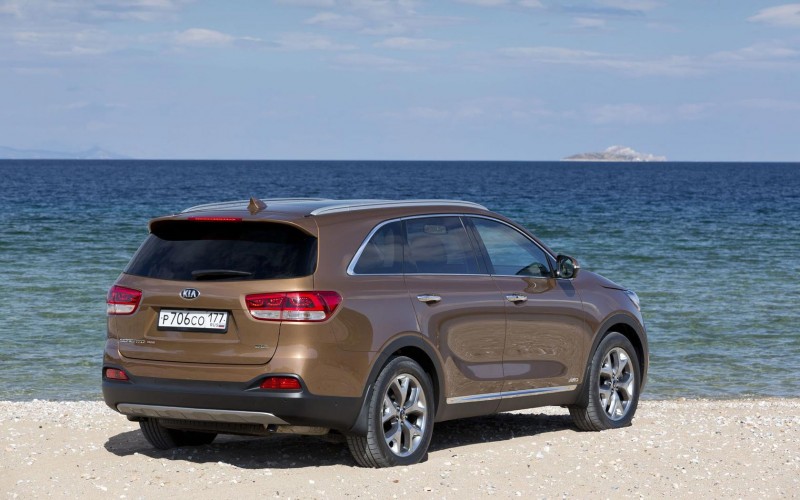
AFLS service was also installed, which allows to improve visibility of the road at night. This is possible due to the fact that the beam of light bulbs will shine where the front wheels are tilted at the moment. Drivers who have a poor understanding of parking will be an excellent assistant to the SPAS system, which is able to scan the entire area and indicates the place that is most suitable for parking. The latest generation of Sorento’s KIA has passed a list of crash tests under the IIHS staff program.
This includes a frontal collision with a small and medium overlap at 64 km/h (in the 1st case it covers ¼ of the entire front end of the driver’s side and in the 2nd case it covers 40%), a side collision with 1,500 kg of deformable obstacle at 50 km/h, roof strength testing and evaluation of AirBag and seat belts. The result is very pleasing – the Korean crossover scored a “good” rating. For all the questions, he was able to win the highest marks. This also applies to the rear impact, which will not result in damage to the head and neck of the spine.
Краш-тест EuroNCAP
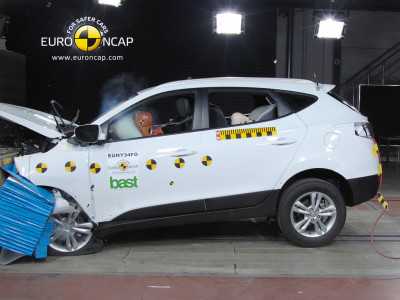
EuroNCAP данная организация была создана в декабре 1996 году в Европе. В нее вошли сразу несколько ассоциаций из Швеции. Первые результаты были опубликованы в 1997 году, это была машина Volvo s40 которая набрала 4 звезды.
Сегодня тесты проводят по нескольким категориям:
- Безопасность взрослых (водителя и пассажиров), это один из самых первых пунктов по которым начали проверять машины. Баллы присуждаются за столкновения с тремя видами препятствий это встречный удар, боковой удар и столб. Так же при краш-тесте стараются учитывать различную комплекцию людей и позы в которых они находятся. Дополнительно проводится тест по защите от хлыстовых травм.
- Безопасность детей, данная оценка направлена на детей дошкольного возраста и тест проводится при использовании детских удерживающих устройств. Последние тесты выявили наиболее безопасную систему крепления ISOFIX.
- Безопасность пешеходов. Пока не погиб ни один водитель при столкновении с пешеходом. Тест разработан для проверки травмоопасности таких частей автомобиля, как капот, лобовое стекло, крылья, бампер.
- Активные системы безопасности. Оцениваются установленные на автомобиль дополнительные системы повышающие уровень общей безопасности. Сигнализатор не пристегнутых ремней, система курсовой устойчивости, система помощи при торможении, ABS и прочее.
Результаты краш-теста Киа Спортейдж 3 поколения и Хендай ix35
По результатам краш-теста который проводился в 2010 году, оба автомобиля набрали наивысшее количество звезд, это 5. А теперь более подробно:
- Безопасность водителя и взрослых пассажиров – Спортейдж набрал 33 балла это 93%. Показав низкую защиту грудной клетки при столкновении со столбом. Хендай же набрал 32 балла и 90%
- Защита детей здесь Киа набрал 42 балла и 86% а Хендай 43 балла и 88%
- Защита пешеходов. Спортейдж 3 поколения показал не очень хорошие результаты набрав всего 18 баллов и 49%. Hyundai ix35 держался лучше и получил 20 баллов и 50%.
- Системы безопасности наличие сигнализатора ремней у задних пассажиров у Киа дали ей дополнительный бал, итого 6 и 86 %. У Хендай 5 и 81%.
Результативность краш теста Киа Соренто третьего поколения
Когда тестеры добрались до Kia Sorento 2015-2016 третьего поколения, то предстала перед ними совсем иная картина. При проникновении узкого барьера максимальная глубина проникновения ограничилась 10-сантиметровым значением, при этом при ударе и после него тело манекена на месте удерживалось. Датчиками было показано, что при таком ударе в реальном ДТП перегрузки не смогут серьезных травм нанести.
Новый и предельно сложный для прохождения Киа Сорентов 2015 краш тест от испытателей IIHS позволил получить в своем классе корейскому внедорожнику титул «Самого безопасного выбора». Аналогично высокую результативность показали внедорожные авто Nissan Pathfinder и Toyota Highlander. При этом Ford Explorer с Jeep Grand Cherokee признаны «средними». А вот худшие показатели были у уходящего поколения Honda Pilot.
Киа Соренто краш тест видео
Водитель или взрослый пассажир
Устройства обеспечения безопасности
- Хорошая
- Достаточная
- Низкая
- Слабая
- Плохая
The passenger compartment remained stable in the frontal impact. Dummy readings indicated good protection of the knees and femurs of the driver and passenger. KIA showed that a similar level of protection would be provided to occupants of different statures and to those sat in different positions, whose knees might contact the dashboard in different places. In the side pole test, protection of all critical body regions was rated as good and the Sorento scored maximum points. Even in the more severe side pole test, maximum points were scored, with good protection of all body areas. Tests on the front seats and head restraints indicated good protection against whiplash injuries in the event of a rear-end collision. A geometric assessment of the rear seats, including the optional third row, also indicated good whiplash protection for these seating positions.
«Третий» Sorento прошел комплекс краш-тестов по стандартной программе IIHS. Он включает в себя лобовое столкновение с малым и средним перекрытием на скорости 64 км/ч (в первом случае перекрывается 25% передней части со стороны водителя, во втором – 40%), боковой удар с 1500-килограммовым деформируемым препятствием при 50 км/ч, тест на стойкость крыши и оценку функционирования подушек и ремней безопасности.
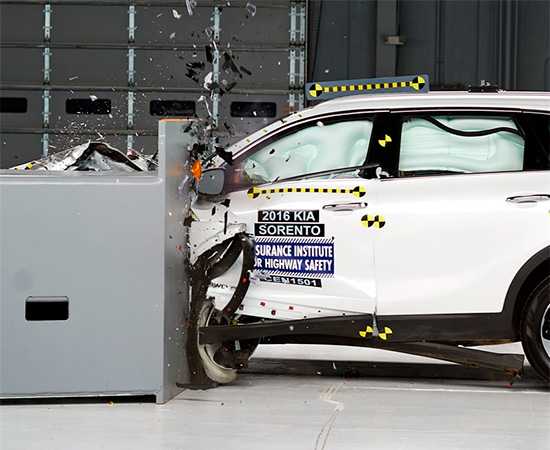
По итогам всех испытаний «кореец» получил максимальный рейтинг – «хорошо».
При фронтальном столкновении с 25-процентным перекрытием высотой 1.5 метра Kia Sorento обеспечивает высокий уровень безопасности: передняя стойка у порога деформировалась всего на 10 см, а манекен хорошо контролировался ремнем безопасности, который работал сообща с подушками безопасности. Тем самым существует низкий риск образования каких-либо серьезных травм.
При лобовом контакте со средним перекрытием водитель, пристегнутый ремнем безопасности, наделен должным уровнем защиты со стороны передней подушки и боковых занавесок безопасности. Всем частям тела предоставляется хороший уровень защиты, что исключает вероятность получения опасных повреждений.
Во время бокового столкновения водитель и пассажиры в «третьем» Kia Sorento имеют низкий риск получения каких-либо значительных повреждений, кроме того исключен опасный контакт головы каждого из седоков с жесткими структурами интерьера. Такая степень защиты обеспечивается за счет боковых подушек и шторок безопасности.
Удачно кроссовер справился с тестом на прочность крыши, когда на нее с постоянной скоростью давит пластина из металла. Для получения хорошего рейтинга необходимо, чтобы прилагаемое усилие было как минимум в четыре раза больше снаряженной массы автомобиля. У Kia Sorento соотношение прочности к весу составило 4.7. Это означает, что при опрокидывании «кореец» надежно защитит сидящих внутри людей.
Максимальное количество баллов «Соренто» 3-го поколения заработал за безопасность пассажиров в случае наезда сзади. От повреждений головы и шейного отдела позвоночника отлично уберегают подголовники и сиденья.
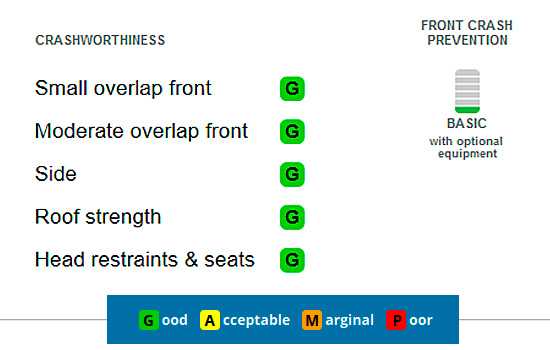
По умолчанию Kia Sorento 2016 модельного года оснащается передними подушками безопасности, боковыми подушками безопасности для передних и задних седоков, антиблокировочной системой тормозов, электронной технологией контроля курсовой устойчивости и устройствами Isofix для детских кресел.
Interior
It was very gratifying that Korean specialists did not just move the really successful interior from the second generation to the third one. Often firms apply this action, adding only a minimum of adjustments. However, in our case, it turned out to be the opposite – the interior has learned new, vital, became more attractive and unique, which can be perfectly seen in the photos. All the lines seem to remain recognizable, but because of the large number of new elements has become noticeably fresher and brighter. As a result, the KIA Sorento driver now has a new, anatomically correct and comfortable steering wheel.
Following it, the architecture of the front panel and the central console has changed, which was also upgraded. The seats installed in the front were changed, and the seats in the second and third rows were also changed. By the way, yes, the Korean will be offered with 3 rows of seats, but the 3rd row will be supplied only optionally, so if you need it a lot of seats, you can buy a car only with 2 rows of seats.
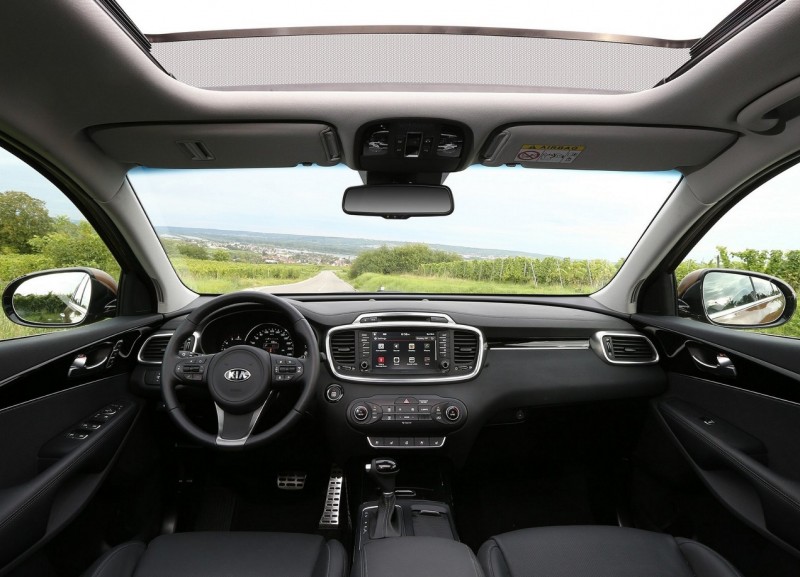
I would like to note at once that the machine turned out to be quite comfortable and multifunctional from the inside. High quality finishing materials were used, seats were installed very comfortable, and no matter what it is a row, first, second or third. There is a competent and well-thought-out layout. The seats installed at the front have a distinctly pronounced side support and provide a very comfortable fit. Rear seats are able to move along the interior and change the angle of inclination of the backrests. As a result, the standard 605 litres of free luggage space will not be considered the limit. If the first row of seats has got function of heating and ventilation, that 2nd row only heating system. The third row can count only on cool air coming from the air conditioner from the deflectors installed on the sides.
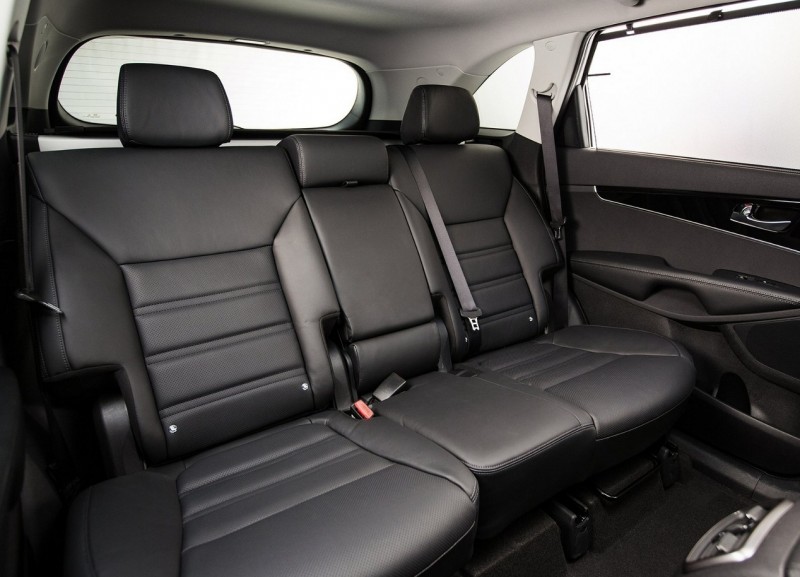
Thanks to the increased wheelbase, the comfort and free space on the 2nd and 3rd rows was increased. Moreover, the interior of the KIA Sorento has an excellent level of noise isolation, because it was foreseen fresh materials of soundproofing content and new panels, which separate the transmission and power unit department from the interior. Of course, it is clear that the third row of seats will not be so comfortable for three adults, except if you put the children there. By the way, if you add up the second row of seats and remove the third one, it will give a whole 2,080 liters of free space.
